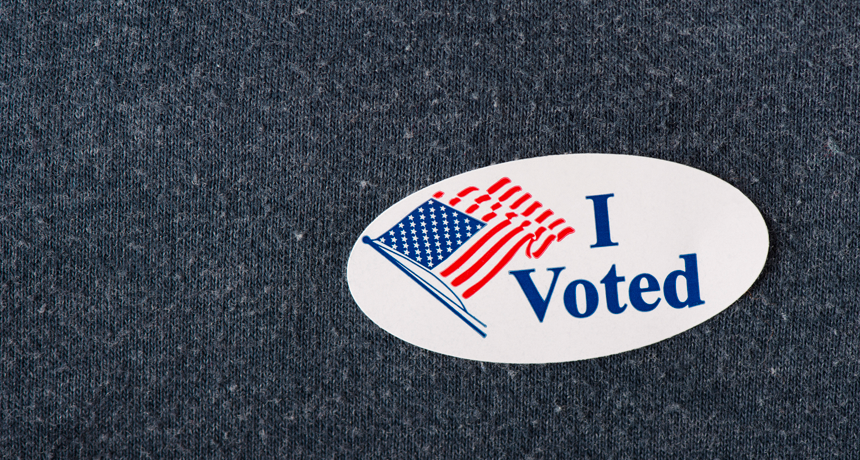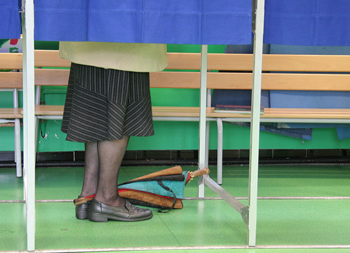4 research-backed ways to get people to vote
Scientists are finding ways to increase voter turnout

Millions of Americans will be lining up to vote on November 8. Millions will also stay home. But scientists have insight into how to convince people to vote.
IcemanJ/istockphoto
Every two years, on the first Tuesday (after a Monday) in November, Americans should head to the polls to take part in a national election. Some important elections may take part in the off-years as well. But not everyone who is eligible to vote will do so. In fact, millions of people won’t. And that’s a problem because people who don’t vote lose out on a prime chance to register their views. Also, voting isn’t just important. It is a privilege and a right that many people throughout the world lack.
One person’s vote probably won’t change course of an election. But a few thousand votes — or even a few hundred — certainly can. Consider, for instance, the famous election between George W. Bush and Al Gore in 2000. Once the polling was over, Florida had to recount its votes. In the end, Bush won by 537 votes. That difference decided who became president of the United States.
Even in polling for local offices — such as a school board — the result of a vote can change everything from what schools neighborhood children will attend to whether their textbooks will cover evolution.
There are many reasons why people don’t vote. And to counter the anger, apathy, fatigue and other factors that deter many folks from voting, organizations big and small mount campaigns urging people to go to the polls. Facebook users may plead with their friends. Politicians may hire phone banks to call thousands of people in states where a race appears to be very competitive. Celebrities may beg over YouTube. Does any of this really work?
Political scientists have studied ways to change people’s voting behavior. These four methods seem to stand out in terms of being most effective.
1) Educate early and well Messages that people receive early in life have a strong impact on whether people vote, notes Donald Green. He’s a political scientist at Columbia University in New York City. Parents and teachers should therefore let kids know “voting is important,” he argues. “It’s what makes you a functioning adult.” Teachers might help deliver this message in classes where students learn about how their country and government functions. That happened to me in high school when my own teacher one day begged me and my classmates to vote.
People with college degrees are also more likely to vote. Perhaps society should make it easier for people to afford college. “A person who gets a college education ends up in a different life circumstance,” explains Barry Burden. He’s a political scientist at the University of Wisconsin–Madison. College graduates tend to associate more with people who vote — and then they vote, too. They also stand to earn more (paying more taxes), data have shown. So a more educated population should be a win-win for society.
2) Peer pressure A healthy dose of name and shame can have a big effect on Election Day. Green and his colleagues demonstrated this in a study published in 2008 in American Political Science Review. They applied a little social pressure to voters.
Right before Michigan’s 2006 Republican primary, the researchers selected a group of 180,000 potential voters. They mailed about 20,000 voters a letter asking them to do their “civic duty” and vote. They mailed another 20,000 a different letter. It asked them to do their civic duty, but added that they were being studied — and that their votes were a matter of public record. (In some states, such as Michigan, voting records are publicly available after an election.) A third group got the same messages as the second group. But they also got a note that showed them their previous voting record, and the previous voting records of the people in their household. A fourth group got the same information as the third group, as well as being shown the publicly available voting records of their neighbors. The last 99,000 people or so were a control — they got no mailings at all.

After all the votes were counted, the scientists saw a 1.8 percentage point increase in turnout by people who had been reminded to vote over those who did not get such a mailing. For the group told their votes were a matter of public record, there was a 2.5 percentage point increase. But the biggest increase were among those shown voting records. Turnout increased by 4.9 percentage points among people shown their previous voting records. And if voters were also shown their neighbors voting records, turnout at the polls rose a whopping 8.1 percentage points.
Although shaming may get out the vote, Green cautions that it likely also burns bridges. “I think it produces backlash,” he says. In the 2008 study, many of the people who received the letter that showed the voting records of their neighbors called the number on the mailing and asked to be left alone.
Peer pressure doesn’t always have to be mean, though. Asking friends directly to pledge to vote — and then making sure they do — might be effective, Green says. The most effective thing to do, he says, may be to say to a close friend or coworker, “let’s walk to the polls together.”
3) Healthy competition “People are going to participate when they think they are going to make a difference,” says Eyal Winter. An economist, he works at the University of Leicester in England and the Hebrew University of Jerusalem in Israel. He notes that there is higher voter turnout when an election is close and there’s no telling who might win. Winter compares elections to football or baseball games. When two close rivals face off, their competitions will draw much bigger crowds than when one team is sure to roll right over another.
To find out whether a close election might make more people vote than a race where one politician is far behind another, Winter and his colleague looked at U.S. elections for state governors from 1990 to 2005. When surveys before the election showed that results were likely to be very close, voter turnout increased. Why? People now felt their vote might make a bigger difference.
More voters also turned out for the side with the slight majority in the poll. “It’s nicer to support your team when you’re expected to win,” Winter explains. He and his colleague Esteban Klor — a political scientist at the Hebrew University of Jerusalem — published their findings in 2006 on the Social Science Research Network.
4) The personal touch Hundreds of studies have been done on what gets people to vote. Some of the studies might be partisan — focusing on people who support a particular party. Others might focus on both major parties or even on people in general. Such research has probed everything from the how much money to spend on voicemail messages to crafting the ideal subject line for an email.
Many of these ideas are described in Get out the Vote: How to increase voter turnout. This book was written by Green and his colleague Alan Gerber of Yale University in New Haven, Conn. The 2015 version of the book includes chapters on social media, mailing letters to people’s houses and putting signs along highways. Letters and signs, computerized phone calls and Facebook posts all seem to help a little. But the most effective methods employ face-to-face and one-on-one discussions of the candidates, Green says. For politicians this means walking door to door (or having volunteers do it).
But maybe someone just wants to get a sister or friend to vote. In that case, Green says the most effective message might be to convey your own enthusiasm for the candidates, the issues and how much you’d like to see that person vote.
Appealing directly to friends and family might help them get to the polls on Election Day. But keep in mind that everyone has their own opinions on the candidates. Even if you get your friends and family members to vote, they might not vote the way you’d like them to.







